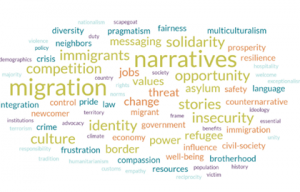How narratives are shaping migration policy
A new study delves into how competing narratives are shaping views and policy on migration across the world.
The study by the US-based Migration Policy Institute, Metropolitan Group, the RAND Corporation and the National Immigration Forum is titled How We Talk about Migration: The Link between Migration Narratives, Policy and Power.
 It says while some narratives emphasise positive aspects of migration and the humanitarian, cultural and economic benefits of accepting people from other parts of the world, other narratives create division and suspicion of newcomers.
It says while some narratives emphasise positive aspects of migration and the humanitarian, cultural and economic benefits of accepting people from other parts of the world, other narratives create division and suspicion of newcomers.
“There is dissonance between top-down narratives from government and political leaders, and bottom-up narratives that spread through person-to-person contact, media and social media channels, and other popular outlets,” the report says.
“Both top-down and bottom-up narratives can be ‘positive’ – viewing immigration as an asset or source of pride – or ‘negative’ – viewing migration as a threat and can be used—and at times manipulated— to advance different agendas,” it says.
“The COVID-19 pandemic added a new layer of complexity to the conversation about the role of migration and migrants. While in some places negative narratives about migration have intensified since the onset of the public-health crisis and resulting economic disruption, communities also are experiencing new waves of solidarity with migrants.”
The report comes as international migration has more than tripled worldwide since 1960, with some of the most dramatic increases seen in places least accustomed to large-scale movements across borders
“This rapid social and demographic change in many countries around the world has triggered a new reckoning around what immigration means for societies, giving rise to a plethora of narratives or stories about how the movement of people across international boundaries reinforces—or undermines—national values, security, and prosperity,” the report says.
“As more people globally are on the move and migration levels rise, societies with large numbers of immigrants are facing competing narratives about migrants and migration,” it says.
Significantly, the report points out that narratives in turn influence migration policy in powerful ways, shaping how challenges are defined and contextualised, where responsibility is assigned, and what solutions are proposed.
“Perhaps most vividly, narratives can be used, or misused, to drive changes in policy direction. Narratives can be actively orchestrated and shaped – for example, through organized messaging campaigns or government speeches – or they can be engrained but diffuse, such as the idea that the United States is a “nation of immigrants,” the report says.
“They can be spread through peers and neighbours, through media and social media, and by politicians at all levels. Narratives can also develop and take root in institutions, particularly those responsible for crafting and implementing policy. They can spread in different parts of government, such as law enforcement institutions, the private sector – including employers, and civil society – such as nongovernmental organizations or advocacy groups,” the reports says.
The researchers conducted a literature scan covering five countries – Colombia, Lebanon, Morocco, Sweden, and the United States – chosen to illustrate the diverse geographic, political, and cultural contexts in which migration narratives shape policy and because all of the countries have seen increased migration over the last decades as well as significant public debate over migration policy.
They identified several key trends:
Many positive migration narratives invoke feelings of national pride rather than attempting to “sell” concrete benefits of migration.
“In many countries, top-down stories about migration tap into core notions of national identity and attempt to invoke pride, such as being a nation of immigrants (in the case of the United States) or being recognized for a diverse heritage (Morocco),” the researchers said.
Elite, top-down messages about migration often clash with views on the ground.
“Many government leaders spread messages about the benefits of migration, but these do not always align with people’s lived experiences. And in many places, the public has a fundamental mistrust of government or perceives policymakers have failed to effectively manage migration challenges, which can also spark scepticism,” the researchers said.
The most dominant threat narratives are driven by insecurity—whether related to economics, culture and identity, personal safety or national security.
“The stickiest negative narratives about migration are often interwoven with perceived threats to economic, physical or cultural security, even if these threats are not well supported by data. Migrants competing with citizens for jobs was a narrative theme found to some extent in all case-study countries, regardless of the health of their labour market,” the researchers said.
There is often a tipping point when feelings of acceptance shift and feelings of insecurity begin to dominate.
“Welcoming stances toward migration are not always permanent. Even when they are rooted in core values, if countries have immigration levels perceived as too large or increasing too quickly, a tipping point may be reached where narratives of threat, loss and fairness gain power,” the researchers said.
Read the full report here: https://www.migrationpolicy.org/research/migration-narratives-policy-power












